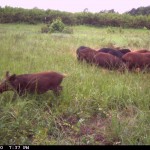Writer: Paul Schattenberg, 210-859-5752, paschattenberg@ag.tamu.edu
Contact: Dr. Jim Cathey, 979-458-2565, james.cathey@ag.tamu.edu
COLLEGE STATION – The Texas A&M Natural Resources Institute, NRI, encourages landowners to report wild pig sightings and damage using a new first-of-its-kind online tool.
“Landowners throughout Texas are constantly seeing wild pigs and their damage,” said Dr. Jim Cathey, associate director of the NRI. “Unfortunately, until now, we didn’t have a good method of collecting the information on where the pigs were sighted and what type of damage they were doing.”
Cathey said the new easy-to-use reporting tool, developed by the institute’s data analytics team, provides a unique portal for Texas landowners and homeowners to note and quickly report such sightings. It can be found in the “Report Wild Pigs” section of the institute’s Wild Pigs website at https://wildpigs.nri.tamu.edu/.

A sounder of wild pigs roams the Texas landscape. (Texas A&M AgriLife Extension Service photo courtesy of Dr. Billy Higginbotham)
“For many years, Texas A&M AgriLife Extension Service has worked through its county agents to bring programming that frames the problem Texans face when dealing with wild pigs,” Cathey said. “Those programs on biology, wild pig reduction techniques, and laws and regulations spurred a lot of ‘pig stories,’ and the number of those stories has grown over time.
“Now instead of hearing wild pig reports by individuals, this new tool will allow landowners to capture the information so it can be used in a statewide database that will allow everyone to really understand the breadth of the wild pig problem across Texas.”
Cathey said it takes only a few minutes for a landowner using the tool to capture data on the wild pigs and includes an option for submitting photos of the animals and/or their damage.
“The site has a location feature with a GPS map interface so you can click and show exactly where the wild pigs or the damage they had caused was sighted, and it gives the longitude and latitude of that location,” he said.
“The electronic fill-in survey allows the landowner to notate specific information, including the number of pigs seen, the class of pigs — whether male, female, younger or older — the kind of damage, such as wallowing and rooting, and what type of damage there is, such as crop or landscape damage or torn fencing.”
Cathey said data from the submitted reports will be used to support the institute’s outreach efforts and help locate areas of high activity to guide both land management and educational efforts across the state.
“Wild pigs are one of the greatest invasive species problems in the United States, having a negative effect on agricultural crops and livestock, water quality, wildlife populations and their habitats, and more recently, suburban landscapes,” he said. “There are an estimated 5 million wild pigs throughout the U.S. with an estimated 2.6 million in Texas alone. And the wild pig crop damage and control costs are reported to be greater than $52 million annually in Texas.”
He said $52 million annually in damage is tied to agricultural damage and doesn’t tell the type or extent of damage wild pigs may be causing in the more suburban areas of the state.
Cathey said in areas where wild pig populations are concentrated near streams and other water bodies, they contribute bacteria, including some forms of E. coli known to be harmful to humans.
“Wild pig populations can substantially impact water quality by eroding banks, increasing sediment loads and algae blooms, and causing oxygen depletions,” he explained. “Our work in identifying wild pig populations and providing useful information on their control has helped many stakeholders become actively involved in implementing water resource management and protection programs in their watersheds.”
Cathey said AgriLife Extension county agents have been successful in providing opportunities to relay educational information to landowners about effective wild pig removal and management, which is critical in reducing wild pig populations and improving the water quality of Texas streams.
“Through presentations, publications, smartphone applications, social media content and videos done in collaboration with Texas State Soil and Water Conservation Board, we hope landowners and the general public will be able to know more about the biology and behavior of these animals even as we improve on those reduction measures used to control them,” he said.
For additional resources on wild pigs, go to https://bit.ly/2E8j6Rb.
-30-


